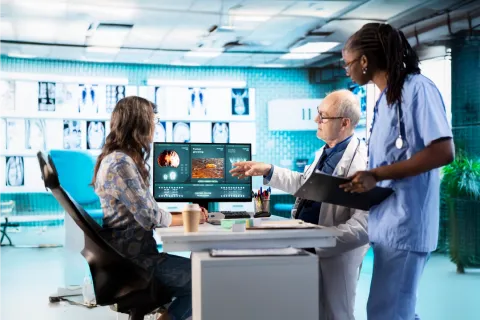
Post-market Surveillance (PMS), in the context of Quality Management Systems (QMS), refers to the systematic approach to collecting, recording, and analyzing data on the quality, performance, and safety of a medical device throughout its entire lifecycle, actively and continuously. This process is an integral part of a manufacturer’s QMS. It is essential for ensuring that a medical device continues to meet its intended purpose and remains compliant with the Essential Principles of Safety and Performance.
The Importance of PMS
The significance of PMS lies in its ability to identify and address any adverse events, product malfunctions, or failures that may occur once a medical device is in use. In fact, it helps manufacturers to:
- Investigate and act on any adverse events or product issues detected by end-users.
- Determine if the risks associated with the device have increased and whether the benefits still outweigh the potential harms.
- Implement necessary field safety corrective actions, such as recalls or changes to the product or its labeling.
- Update the risk-benefit ratio determination and improve risk management strategies.
- Update the design, manufacturing information, Instructions for Use (IFU), and labeling based on real-world data.
- Ensure the continued safety and performance of the device, thereby protecting the health and safety of patients, healthcare professionals, and other users.
Challenges of Integrating PMS into QMS
There can be many challenges during the post marketing surveillance for QMS, which include:
- Detecting Unexpected Adverse Events: One of the primary challenges is the detecting adverse events that had not been identified during the pre-marketing phase. Since no pre-marketing review can predict all possible device failures or adverse events, it is only through the actual use of the medical device that unforeseen problems related to its safety and performance can be detected. This requires a robust system for adverse event reporting and analysis, which can be difficult to maintain and manage.
- Ensuring Product Efficacy: PMS must confirm that the medical device continues to perform as intended and that its benefits outweigh its risks when in use by the general population. This involves continuous monitoring and evaluation of the device’s performance, which can be challenging due to the variability in how devices are used in real-world settings.
- Managing Evolving Regulatory Requirements: Regulatory requirements for medical devices are constantly evolving, and manufacturers must stay up to date on the changes to ensure continuing compliance. Thus, they need to understand and implement new guidance documents, standards, and regulations that may affect PMS activities.
- Global Alignment and Standardization: There is a lack of global alignment of terminology and processes related to adverse event reporting and safety notices/recalls. This can, in turn, lead to challenges in achieving a comprehensive overview of device safety and communicating with international Regulatory bodies.
- Data Collection and Analysis: Manufacturers are required to collect specific and structured post-market data, which must then be systematically analyzed. The data collection process must be proactive and capable of capturing relevant information on quality, performance, and safety throughout the device’s lifecycle. This requires significant resources and expertise.
- Resource Allocation: Maintaining a QMS with an effective PMS component requires appropriate human resources, infrastructure, and management. This includes the need for ongoing training, stock management, and maintenance, which can be a resource-intensive process.
- Utilization of Real-world Evidence: There is a growing interest in using real-world evidence for PMS and other Regulatory processes. However, integrating this type of evidence into the QMS and Regulatory decision-making can be complex.
Application of QMS to PMS
QMS principles can be applied to PMS processes in several ways to ensure the continued safety, quality, and efficacy of medical devices after they have been placed on the market. Some of the ways are discussed below:
- Establishment of a PMS System: As part of the QMS, manufacturers should establish a systematic process for conducting PMS, which is proportionate to the risk class and appropriate for the type of device. This system should actively and systematically gather, record, and analyze data on the quality, performance, and safety of the device throughout its entire lifecycle.
- Integration with Existing QMS Procedures: The PMS procedures should supplement the internal procedures for post-market activities that are already an integral part of the manufacturer’s QMS. This ensures that the surveillance activities are consistent with the overall quality objectives of the organization.
- Complaint Handling and Vigilance Reporting: The QMS should include processes for effective complaint handling, post-market vigilance reporting, and management of any subsequent Corrective and Preventive Actions (CAPAs). This ensures that any issues identified at the post-market stage are addressed in a timely and systematic manner.
- Documentation and Record-keeping: The manufacturers should document all PMS activities and maintain records as part of the QMS. This documentation and record-keeping should include plans, procedures, and reports related to PMS activities.
- Risk Management: The QMS should incorporate risk management principles, including the analysis of PMS data to assess any changes in risk profile and the need for actions to mitigate risks.
- Continuous Improvement: Manufacturers should feed information obtained from PMS back into the QMS to drive continuous improvement. This includes updating the risk management file, design and manufacturing information, and any labeling or IFU.
- Regulatory Compliance: The QMS should ensure that all PMS activities comply with the applicable Regulatory requirements, including specific reporting timelines and actions required by National Regulatory Authorities (NRAs).
- Training and Resources: The QMS should allow for the necessary human resources, staff training, and infrastructure building, so that the manufacturer can avail of these to conduct PMS activities effectively.
- Cooperation with NRAs: Manufacturers should cooperate with NRAs in charge of vigilance and market surveillance activities, sharing relevant data and information obtained through their PMS activities.
Significance of QMS Integration into PMS
Integrating QMS principles into PMS activities is crucial for medical device companies to ensure product quality, safety, and Regulatory compliance. A QMS provides a structured approach that helps monitor devices throughout their lifecycle, manage risks by analyzing real-world performance data, and respond to adverse events efficiently. In fact, there is an emphasis on continuous improvement of a device once it is on the market, which can be done only by using surveillance data. Regulatory bodies mandate PMS as part of QMS to ensure that medical device manufacturers maintain compliance with safety and performance standards. Integrating QMS into PMS safeguards patient health, builds the brand image, and offers legal and financial protection by proactively addressing post-market issues, thereby potentially reducing the risk of recalls and reputation damage. Overall, imbibing QMS principles in PMS supports patient safety, risk management, and ongoing improvement in medical device quality and performance.
To sum up, integrating QMS principles into PMS plays an important role in improving medical device safety, quality, and efficacy while also ensuring compliance with the necessary regulations. Get in touch with Freyr, an expert in Regulatory solutions, and developing an effective PMS framework as a component of your QMS. Schedule a call with us today to get end-to-end Regulatory support!









